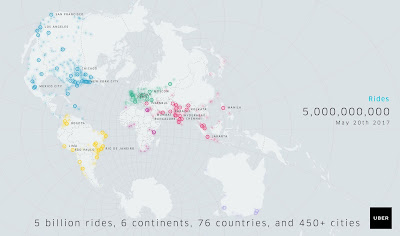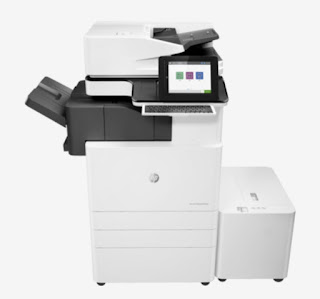 |
| Source: Uber. Uber has been responsible for over 5 billion rides as of May 2017. |
In late 2015, Uber hit a big milestone: 1 billion trips. Six months later, in 2016, Uber has over 5 billion rides under its belt. The key trips occurred on 20 May 2017; 156 trips started simultaneously at 7:29:06am GMT in 24 countries on six continents including Malaysia put Uber over the 5 billion mark.
The shortest trip of the batch lasted 470m in San Francisco, US, and the longest was for 27km in Singapore (which is 50km wide). Fifteen of the riders, Uber said, were using Uber outside of their home city.
In Malaysia, two driver partners were involved in the milestone. Zabidi Hassan, a full-time driver-partner from Kuantan said, “It really was a surprise to learn I was one of the driver partners that helped Uber achieve the 5 billionth trip mark.” Zabidi, a driver partner for just one month, added, “It is my main source of income – I’m really happy with it. I’m truly excited to be part of this achievement.”
The other driver partner is Hardeen Sirajudeen, a freelance property agent who drives part-time on Uber. He said, “I find it easy to use and the flexibility I have to earn really helps a lot.”
On being one of the 156 drivers, Hardeen commented, “I’m really glad to be part of something like this. It was just a normal day for me, but what a surprise it turned out to be! This is only possible because Uber is here in Malaysia, and it motivates me to drive more. I’m grateful to Uber for this.”
To say thanks, Uber is giving all 156 drivers, including Zabidi and Hardeen, a one-off incentive of US$500.
Fun facts on the 156 simultaneous trips on the road to 5 billion trips:
Longest trip: 17.1 miles (27.5km), uberPOOL, Singapore
Shortest trip: 0.29 miles (0.47km), uberX, San Francisco - Uber's first location
Longest tenured driver - 3 years 6 months (since first trip) - an UberX driver-partner from Atlanta, Georgia, USA who has completed 1,911 trips.
Shortest tenured driver – 0 days (their first trip) - An uberMOTOR driver-partner from Jakarta, Indonesia.
Six riders were on their first trip, including in Jakarta; Islamabad, Pakistan; and Chennai, India.
Fifteen riders were using Uber outside their "home city", which is defined as the place where they use Uber most often
Eight Uber products were on the road at the same time: uberX, UberXL, uberPOOL, UberBLACK, uberMOTOR, uberGO, UberSELECT, and UberVIP. Only uberX, UberXL, and UberBLACK are available in Malaysia.
Uber Malaysia recently reiterated its commitment to safety through new features and initiatives, including a partnership with the Royal Malaysian Police (Polis DiRaja Malaysia or PDRM) to feature their Volunteer Smart Patrol (VSP) app and the formation of an Uber Safety Lab that allows Uber Malaysia to regularly tap on stakeholders and industry experts to improve safety.
The VSP enables the public to become the eyes and ears of the police force and send them real-time visuals of any incident through smartphones. This is a concrete step towards the SOS Button that the regulators have required of e-hailing apps.
“We believe that technology can have a positive transformative effect on our way of life, and we believe that by continuing to improve on how the Uber app connects riders with driver-partners, we can further strengthen public confidence in e-hailing technology, which has benefited millions of people to date. In Malaysia, ride-sharing remains the preferred mode of transportation, and through our new features and initiatives, we aim to not only strengthen confidence in the Uber platform but also surpass public expectations. Everyone has a right to be safe, whether they’re on a train, in a cab, walking on a sidewalk or in an Uber. And while no means of transportation can be 100% incident or accident-free, technology can improve safety by creating accountability and transparency where previously there was none,” said Chan Park, Regional GM, Southeast Asia.
Uber incorporates GPS tracking for every trip, giving people the ability to share their trip information and estimated time of arrival (ETA) in real-time with loved ones. Uber also has a two-way feedback feature so that both riders and driver-partners can give feedback on any trip. Such features allow Uber to respond quickly and provide authorities the necessary information to assist them in their investigations. Rider issues are highlighted via machine-learning that is able to pick up keywords from the feedback provided. To date, Uber has been able to solve issues highlighted by riders and drivers within 24 hours from the time it is reported. Uber’s data has also shown that 50% of all issues are solved within 6 hours.
Currently, Uber Malaysia is focused on:
- Reviewing and improving processes and technologies to prevent exploitation of the Uber platform for criminal purposes.
- Engaging closely with SPAD (the regulator), PDRM (the Police), and other relevant stakeholders for their views on how we can further improve.
- Reaching out to other organisations and agencies in Malaysia, as well as taking lessons from Uber operations throughout the world.
- Educating both riders and drivers on how they can do their part to ensure their own safety.
Riders are reminded to practice caution when using ride-hailing apps, and to:
- Be kind and respectful. As outlined in Uber’s community guidelines, please respect your driver and his or her car.
- Only take trips with drivers you request through the app - there are no street hails with Uber.
- Before the ride begins - Doublecheck the licence plate, driver name and photo shown to you in the app. We encourage riders to doublecheck all these details and make sure they match the driver and car. Riders are also able to see a driver's rating to determine if they wish to proceed with a journey.
- During the trip - Share trip details with friends and family. Riders can share their trip details, including estimated time of arrival and the specific route, with friends and family so they can follow the trip and know when they've arrived safely.
- After the ride ends - Provide feedback. Riders rate their driver and vice versa, and can provide feedback to Uber. Our safety team reviews this information and investigates any issues. Uber customer support is available 24x7.
posted from Bloggeroid










